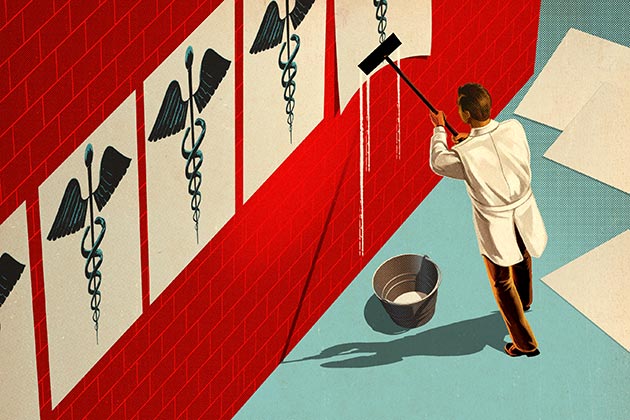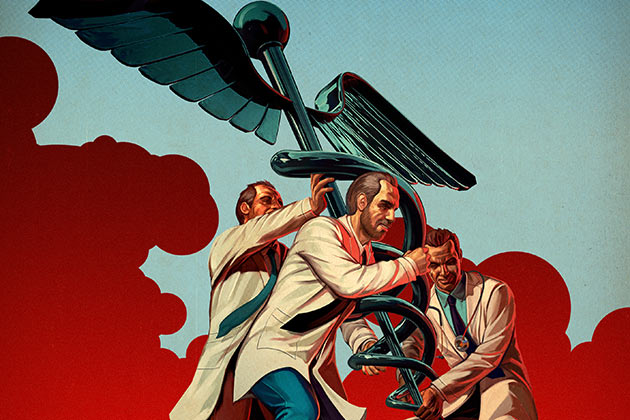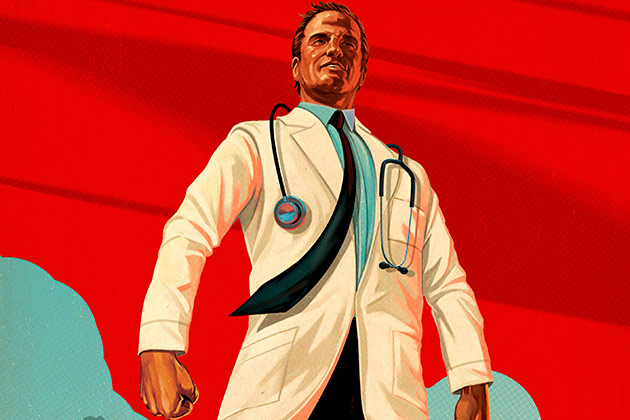Published On June 10, 2016
LAST SUMMER, pediatrician Mona Hanna-Attisha was enjoying dinner with a friend at her home outside Flint, Mich. Her guest, an environmental scientist, was expressing growing concerns about the local water quality. The city had started drawing its water from the highly polluted Flint River without taking precautions to prevent corrosion of the city’s lead-lined water pipes. While some residents had complained about the brown, foul-smelling water coming out of their taps, state and federal regulators had assured them that it was perfectly safe.
Hanna-Attisha, who works at Flint’s Hurley Medical Center, knew that if there were elevated levels of lead in the water, it would pose a threat to the city’s children. She began asking for data about the lead levels that had been reported in children from the county, and when those were unavailable, she searched the health records of children at her own hospital. Rates of lead poisoning had doubled since the city had changed its water source, the records showed, and she announced her findings at a press conference, urging the city to stop using Flint River water.
The blowback was swift. A spokesman from the Michigan Department of Environmental Quality called Hanna-Attisha’s comments “unfortunate,” and assessed the controversy she had helped launch as “near hysteria.” But when subsequent studies confirmed her results, Flint declared a state of emergency, and the complete, tragic story of civil incompetence and political negligence that led to the contamination began to unfold, as did efforts to correct the problem.
Many voices led to the discovery in Flint—the environmental scientist who tipped off Hanna-Attisha, journalists who investigated the story and scientists who carried out their own testing. But the actions of a pediatrician catalyzed the public outcry. “This was physician-led,” says Hanna-Attisha. And as such, the episode in Flint fits into a longer history, one of doctors stepping outside their practices to speak up about the harms in their times, in areas as diverse as child labor, gun violence and human trafficking.

All doctors advocate for their patients, of course, and for some this means fighting with an insurance company to get coverage for an essential therapy, or going an extra mile for a patient who struggles with poverty or a disability. But those who extend that role far beyond their own waiting rooms face a different landscape, one that puts them face-to-face with intractable social problems, politics and a world that doesn’t want to change.
Hanna-Attisha takes her place in a long lineage of physician firebrands. James Parkinson, the eighteenth-century British surgeon for whom Parkinson’s disease was named, was a well-known social agitator who called for better treatment of the mentally ill, and fought for universal suffrage and more democratic representation in Britain’s Parliament. In the early twentieth century, physicians led the fight to curb child labor, and during the Civil Rights era, many traveled to the Deep South both to offer care to the underserved and to patch up the activists who bore the wounds resulting from their nonviolent protest. The current Green Party candidate for U.S. president is a Massachusetts internist who has explicitly linked human health to socioeconomic inequality, industrial agriculture and fossil-fuel-intensive energy production.
Physicians for Social Responsibility, founded in 1961 to report on the medical consequences of nuclear war, helped give rise to the International Physicians for the Prevention of Nuclear War, a group that received the Nobel Peace Prize in 1985. PSR is still active, with 40,000 members, and now fights climate change and toxic chemical pollution, and promotes clean energy. Physicians for Human Rights, founded in 1986, helped lead the International Campaign to Ban Landmines, which won the Nobel Peace Prize in 1997.
Catherine Thomasson, executive director of Physicians for Social Responsibility, says that the modern legacy can trace its history to German physician Rudolf Virchow. In 1848, Virchow was sent by his government to investigate an outbreak of typhus among coal miners in Silesia. German officials likely expected a conventional set of recommendations: medicine, fresh air, something to curtail the spread of lice that carried the disease.
But Virchow, who spent three weeks living with the miners and their families, called for a more sweeping cure. The fundamental problem causing typhus wasn’t a bacterium, he believed, but the squalor in which coal miners lived. His immediate prescription was for better nutrition, housing, sanitation and working conditions. In the longer run, he said, the workers needed better wages, tax reform and political representation. Virchow saw their disease as a physical manifestation of industrial capitalism’s social ills.

One of the more prominent heirs to that legacy is Jack Geiger, an internist and epidemiologist who helped found both Physicians for Social Responsibility and Physicians for Human Rights. Geiger founded America’s first community health clinics in the mid-1960s, and offered malnourished patients prescriptions for food that could be filled at local grocery stores and billed to his clinic. Treating a patient’s social environment in this way came to be known as social medicine, focused on factors that researchers now call the “social determinants” of health.
And improving social determinants, often the target of physician advocacy, has proven to be a battle worth fighting. A 2011 American Journal of Public Health study, for instance, suggested that low levels of education and social support cause as many deaths as, respectively, heart attacks and lung cancer; a 2015 review of social determinants by the Yale Global Health Leadership Institute, a health policy think tank, estimated that 60% of a person’s health is determined by social, environmental and behavioral factors. All of which is to say that advocates who fight for root causes outside the clinic or the hospital have been vindicated, and are needed now more than ever.
Virchow also called physicians “natural attorneys of the poor,” and that role, at least in principle, has become ingrained in the medical community. The Declaration of Professional Responsibility, laid out by the American Medical Association for its members, calls on doctors to “advocate for social, economic, educational and political changes that ameliorate suffering and contribute to human well-being.”
But outspoken advocates in the model of Parkinson or Hanna-Attisha continue to be outliers. Physicians are overworked as it is, and picking a fight with polluters or poverty calls for more raw time than most can find. Physicians who speak up too loudly or too often can also face a cold shoulder in their work environments. Alice Chen, executive director of Doctors for America, a group formed in 2009 to advocate for expanded access to health care, says that as a consequence physicians frequently have a mentality “that we should just put our heads down, take care of the patient and keep our mouths shut.”
Given that culture, what can be done to promote the ideal put forth by the American Medical Association: the doctor who “contributes to human well-being”? Sometimes the seeds of activism are planted by life experience, and simply need to be nurtured. Hanna-Attisha grew up in a family of Iraqi immigrants, and she learned firsthand the hardships faced by outsiders. In high school she became an environmental activist, helping to close a polluting incinerator in nearby Madison Heights, Mich. Jack Geiger ran away from his middle-class Jewish home at age 14, and lived for a year with Canada Lee—a black actor and civil rights champion who would later be blacklisted as an alleged Communist sympathizer in the McCarthy era.
But medical schools can also be a place to cultivate that interest, even when it hasn’t been planted in youth. Several now offer courses in health-related advocacy. At Albert Einstein College of Medicine in the Bronx, primary care physician Aaron Fox teaches in the school’s social medicine program and directs its “Research-Based Health Activism” course, a monthlong elective that draws fourth-year medical school students from around the country. The students develop a project that sets them to work on a social cause in the community of their home school. Past proposals have looked at access to care for formerly incarcerated people living with hepatitis C, tools to help clinicians assess food insecurity or unstable housing, and a rethinking of how electronic medical records affect transgender patients.
But medical school can also have the opposite effect: introducing aspiring physicians to a grind where they face one clinical crisis after the other, with little time to think about global causes that affect their patients. Bon Ku, an emergency medicine specialist at Philadelphia’s Thomas Jefferson University Hospital, teaches a course in medical design, in which students develop DIY devices for use by children in low-income communities. The course is an exercise in putting the issues of the community in front of students, but it is equally valuable, says Ku, as a conscientious respite from the grind. “I’m trying to inoculate them against the hardening process,” says Ku, “in the hope that they become agents of social change.”

Of course, more obstacles to activism will exist once these medical students enter practice. Outright retaliation for advocacy may be rare, but many doctors feel pressured to not be too vocal in supporting unpopular causes, and a physician who takes stands on politically sensitive issues may risk losing patients or incurring institutional disfavor. Mona Hanna-Attisha is quick to credit Hurley Medical Center for supporting her own advocacy, even though as a partly state-funded institution the hospital was in a potentially sensitive situation. Not every institution would be so courageous, she says.
Nor are such issues new. Virchow lost a prize professorship at Berlin’s renowned university hospital Charité, and the American Medical Association tried to blacklist Jack Geiger from medical school. Advocacy always risks ruffling feathers. Manisha Sharma is a family physician in Baltimore, and a mentor for medical students in the region who were organizing for WhiteCoats4BlackLives, a group founded by medical students to eliminate racial bias in the practice of medicine. While employed at her previous job, she climbed on a bench to lead a group of demonstrators in a chant. The moment was captured in an article in The Baltimore Sun, and although it happened during her lunch hour, says Sharma, and thus on her own time, her higher-ups were not happy. They told her she needed permission, a message that helped Sharma decide to leave. “I’m a person before I’m a doctor,” she says. “I’ll always have a job as a doctor, but at the end of the day, I need to be true to myself.”
Hanna-Attisha agrees. Her commitment to pediatrics patients in Flint doesn’t stop when she leaves the clinic. Protecting her patients from outside threats is as much a part of her job as making a diagnosis or writing a prescription. “This is what we do,” says Hanna-Attisha. “When physicians speak, people listen.”
Dossier
The Doctor-Activist: Physicians Fighting for Social Change, by Ellen L. Bassuk and Rebecca W. Carman (Plenum Press, 1996). describes their work on issues such as civil rights, access to health care and environmental protection.
VIDEO: H. Jack Geiger oral history interview, conducted by John Dittmer in New York, New York, March 16, 2013. Geiger discusses how he became a central figure in the Medical Committee for Human Rights.
“On Physician Advocacy,” by Steven L. Kanter, Academic Medicine, September 2011. A synopsis of various tensions, viewpoints and recent writings on physician advocacy.
Stay on the frontiers of medicine
Related Stories
- Fighting for Social Medicine
Jack Geiger discusses the importance of physician activism in promoting community health
- Health Care Blindsided
Mahzarin Banaji explores the role of personal bias in medical care.
- Treating Black Lives
The health care system still delivers poorer care, on average, to African American patients. What can be done?